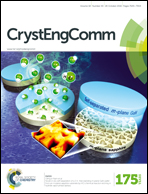Facile synthesis of PtCu3 alloy hexapods and hollow nanoframes as highly active electrocatalysts for methanol oxidation†
Abstract
PtCu alloy nanocrystals, especially for the PtCu3 component, hold great potential as catalysts in methanol oxidation reaction (MOR) owing to their promising catalytic properties arising from the bifunctional mechanism associated with Pt and Cu sites. However, Pt and Cu salt precursors are difficult to be co-reduced in a synthesis due to the large difference in their redox potential, because of which Pt or Cu nanocrystals are initially generated and then evolve into a PtCu alloy with remarkable variation of the PtCu component by underpotential deposition (UPD) and galvanic replacement, respectively. Here we report a facile method for the shape-controlled synthesis of PtCu3 alloy nanocrystals by co-reduction of Pt and Cu salt precursors using oleylamine (OAm) and N,N-dimethylformamide (DMF) as co-reducing agents at different temperatures. PtCu3 alloy hexapods with preferential overgrowth along the <100> direction are obtained at 220 °C through co-reduction reaction accompanied by Cl− ion induced underpotential deposition (UPD). Meanwhile, galvanic replacement between PtCu3 alloy nanocrystals and the Pt precursor co-exists with overgrowth induced by co-reduction reaction at 190 °C, eventually resulting in PtCu3 hollow nanoframes. Both the PtCu3 alloy hexapods and hollow nanoframes exhibit remarkably enhanced catalytic properties in terms of activity and stability towards MOR relative to the commercial Pt/C. Specifically, the PtCu3 alloy hexapods and hollow nanoframes show the highest specific (2.96 mA cm−2) activity and mass activity (1.861 mA μgPt−1) for MOR, respectively, which are 13.5 and 24.2 times higher than those of the commercial Pt/C. This enhancement can be attributed to their unique structures and the possible bifunctional mechanism between Pt and Cu.


 Please wait while we load your content...
Please wait while we load your content...